Fight!
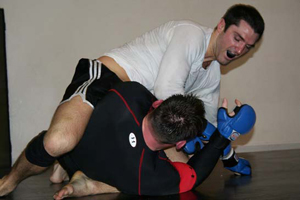
Five years ago if you asked most people who Chuck Liddell was or showed them a photo of the Ice Man he might have been mistaken for a NASCAR fan, not a world champion athlete. Obviously much has changed. Now mixed martial arts (MMA) along with the attendant sports of wrestling, Brazilian Jiu-jitsu, Thai boxing and even stuffy old boxing have witnessed an up-tick in popularity and participation. Unless one lives in a backwater town like Chico, CA it’s an easy proposition to find a good school to train any or all of these arts. The result has been an explosion in the skill sets of current competitors and an amazing acceleration in the development of MMA. However, one component has remained elusive and fairly steeped in voodoo: strength and conditioning. A quick perusal of some of the more popular MMA sites leaves one with the impression that a day of Back & Bi’s followed by Chest & Tri’s with a “little cardio” is the route to optimum fight performance. There are some exceptions like Ross Enamait’s phenomenal work and some material from Parisi. That’s about the extent of what I would tip my hat to.
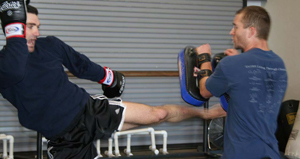
What’s the best approach? It’s tough just looking to the competitors of this relatively young sport. Win/loss has historically been an extension of technical proficiency, particularly in Brazilian Jiu-jitsu (BJJ) however that story has changed in recent times as we have witnessed wrestlers who possess phenomenal conditioning, heart and aggression winning many events and titles with only a modest understanding of BJJ and stand up skills. Thinking back to the beginnings of the UFC this was obviously not the case as smaller, weaker individuals could consistently win against larger stronger opponents, even wrestlers, given adequate technical advantage. Like I said however, times have changed! Now everyone at A-level competition has at least a working knowledge of take downs, submissions and their respective defenses. When the technical field converges upwards what then are the determinants of success? Louie Simmons has made the point that on average when two individuals of equal skill-set compete, the individual who is stronger will prove victorious. Some seem to interpret this to mean start a cycle of anabolic steroids in conjunction with a double split bodybuilding routine. That approach worked for some top-level competitors; however, the evolution of the sport is calling into question bodybuilding as an effective approach to Strength & Conditioning, even with the advantage of anabolics. I’d like to look at some integrative approaches and help to drag strength and conditioning for combatives out of the dark ages. This is not intended to be an exhaustive “How To” guide… that will come later! This is more an open communication of one fighters preparation for competition and what our strategies were along the way.
At NorCal S&C we had the good fortune of prepping a fighter for the rigors of MMA competition, one Glen “The Mad Man” Cordoza. Glen is a phenomenal athlete and coach and will be a major force in the lightweight MMA scene… trust me! Glen was a client of ours several years ago and proved to be a tough and supremely coachable athlete. He worked with us for about five months and then spent the better part of two years in Thailand wracking up an impressive professional Muay Thai record. In addition to Glen’s Thai boxing he had (at the beginning of our training) a blue belt in BJJ under John Frankl and a mountain of experience working with such fight luminaries as Randy Couture, BJ Penn, Marcello Garcia and Eddie Bravo to name a few. Glen’s day job is the role of author for Victory Belt publishing, so he gets to fly to exotic locations, interview the best fighters in the world, and help to write instructional books with these folks. If you like to dismantle people or write and read about the dismantling of people as Glen does, this is a pretty kick ass job.
Before we jump in I want to mention that whenever a client approaches me for help with an element of their performance it’s usually with a specific goal in mind. For some it may be an athletic event like Glen’s fight. For others it may be weight loss or working with a family doctor to reverse hypertension. Whatever the case it’s important for me to thoroughly inventory not only what the person wants or needs to accomplish but also to honestly evaluate where they currently are. From this we can engineer a plan that will address weaknesses and build on strengths to reach a mutually agreed upon goal. This may be obvious for many and I apologize if it seems trite or remedial, but it has been my experience that good coaches have sophisticated means of assessing a client’s status relative to a projected goal. With this information, rational planning can follow. This method also lends itself to cost/benefit projections of the form “Given our current set of circumstances this is how much suffering you will need to endure to get this desired outcome.”
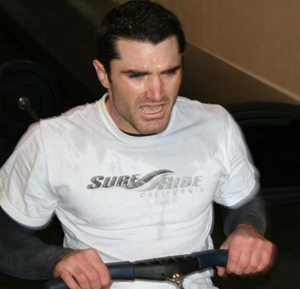
With the above in mind, here is the scenario I faced for Glen’s fight preparation: Glen came to me interested in help with his strength & conditioning for a fight in late March. This was in early January and it seemed we had more than ample time to get Glen in top fight shape. I knew that Glen had excellent stand-up, clinch and ground games and he always took his conditioning seriously. We did, however, have a few interesting twists to this story from day one. The first was that Glen’s normal fight school had closed about three months previously. What this meant was that Glen had very little hands on sparring, rolling or drilling. The second issue was that Glen was in the middle of writing several books, including one with BJ Penn and another with Randy Couture. In essence big, important, time-critical books. The demands of book writing placed Glen in front of a computer for upwards of 10 hrs per day writing, editing and working on page layouts. Glen was stiff, moderately deconditioned (for him) and had a bit of rust on his game… and we had no legit fight school. Hey, we didn’t want this to be a cakewalk!
Once we established where Glen was and where we needed to take him the following points helped to focus our training:
1. Establish an objective measure of sport-specific conditioning.
2. Restore and expand Glen’s fighting skill sets.
3. Implement an effective S&C protocol.
Objective Measures
For an objective measure of sport specific conditioning I chose to use the CrossFit classic Fight Gone Bad. Glen had experience with this workout both from working with us in the past and in his time with BJ Penn. FGB is time indexed to match an MMA fight (three 5 minute rounds) and since Glen had familiarity with the test his improvements would accurately reflect performance improvements and not test improvement. In sports science language, Glen had gone through his acclimatization phase with the FGB test. Glen did however display significant muted hip function on several of the movements, perhaps most notably the push press. This improved over time and correlated nicely with improved scores on this activity. Glen’s first exposure to FGB produced a green, but not unimpressive 276. As we will see later, this number improved dramatically in the weeks to come and by somewhat surprising means.
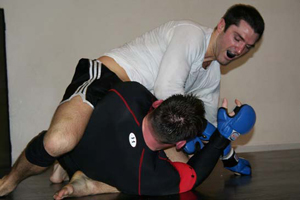
Fight Skills
We began restoration of Glen’s stand-up, clinch and ground skills. I had a decent Thai boxing game at one time so we started working light, technical sparring to re-establish distancing and timing in stand up. Positional sparring was used in BJJ. We started work on the heavy bag and Thai pads. ALL sessions were videotaped and analyzed during flexibility training to make plans for the following day and shore up any weaknesses in the game.
Strength & Conditioning
Integrate effective strength & conditioning. Glen had never followed a specific strength training program. In the past he had used track intervals, dips, pull-ups and some band work for his training with quite good results; however, I wanted to bring up his absolute and relative strength without increasing his weight. Glen fights in the 155 class and runs right around 165. This is not a huge drop to make, but neither of us wanted to push that margin. This considered we started Glen on the deadlift, ring dips and pull-ups. Initially the dead lift was an awkward and challenging movement that exposed a surprising degree of hamstring tightness and what I call a “glassy” lower back. Tight hamstrings and hip flexors appeared to contribute to lower back pain from flexion at the hips. This alleviated with strength and flexibility work. I kept Glen very light and conservative on the strength movements, hammering form while keeping the rep range below 3 to minimize hypertrophy. Even at the light initial loading on the deadlift (62 kg) Glen noticed an immediate improvement in his game. We never maxed Glen but over the course of several weeks we worked him up to very comfortable sets with 100kg in the DL. I will detail this more later; however, it is stunning how much this improved strength added to Glen’s already formidable game. It is important to note also that this strength circuit of deadlifts, weighted pull-ups and weighted ring dip, required less than 15 min to perform and made virtually no inroads into Glen’s recovery capacity. This is a huge consideration when we are pushing the envelope of human performance.
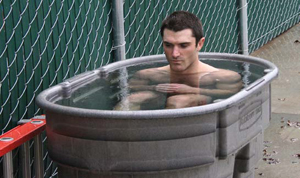
With our objectives in place we started with 2 weeks of general “pre-season” work structured as such:
Warm-up including light shadow boxing, dynamic range of movement and 1K on the concept 2 rower. Next we either worked sport specific activities such as Thai pads, clinch work, BJJ positional sparring and heavy bag work OR we put Glen through his strength circuit comprised of the deadlift, weighted pull-ups and ring dips. I alternated these days so Glen would occasionally do his strength circuit in a fairly fatigued state.
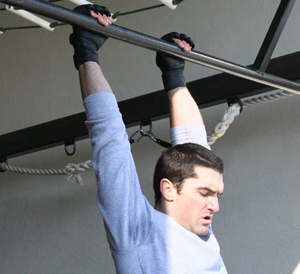
Sets and reps on the strength circuit were 3-5 sets of 2-3 reps. As I mentioned previously, Glen had some difficulty with the deadlift in the beginning. Tight hips made proper position in the beginning of the lift a challenge and it was common for Glen to lose his lordotic arch upon initiation of the lift. Using dynamic range of movement and the Potato Sack Squat (© Dan John Inc) we were able to get Glen into a safe, ergonomically sound position for pulling. It is interesting to note that once we addressed positional/structural integrity, small technique errors in Glens pulling immediately improved. Similar to a math problem, the set-up proved to be all-important. I started Glen very conservatively on the DL with 62 kg and kept him there for about two weeks just hammering form. The ring dips and pull-ups were un-weighted for two weeks, then I began wave loading all the movements, adding a little weight for 2-3 consecutive workouts, then dialing back 1-2 steps. This may not seem to be very aggressive but amidst the rest of Glens training I wanted this strength circuit to be safe, productive and non-taxing. I had Glen move from one movement to the next, with about one minute rest between stations. This allowed for quick completion of the circuit but allowed for 3-4 minutes recovery between each station.
Once the strength circuit or sport specific practice was done we used some form of a mixed modal, CrossFit style circuit. We time indexed efforts to match about five minutes of work and one minute of rest for most workouts; however, I did play with shorter intervals to emphasize power. We also worked hybrid sessions in which Glen wore MMA gloves and included Thai boxing work on either pads or the heavy bag in addition to movements such as running, pull-ups and thrusters. We wrapped up the day with foam rolling, stretching and the daily plunge into the ice bath. Total training time ranged from 1.5-2.5 hours.
This initial two-week period of training brought Glen’s work capacity and anaerobic conditioning up pretty dramatically as evidenced by his 310 FGB score. This was certainly a plus; however, Glen often experienced extreme soreness from the metabolic sessions to a degree that made SSP work vary from unappealing to impossible. As I mentioned before, Glen has a solid MMA game, but we needed to cover many aspects of the fight preparation beyond just S&C. This was late January and a few of the people from the old MMA school in Chico put together a quasi-functional operation about 15 minutes outside of town. Glen could train here and get some reasonably good sparing, BJJ and expert pad work. At this point I wanted to accomplish the following:
1. Shift most conditioning to sport specific work. As the saying goes, the best way to prepare for a sport is to DO the sport. That considered, however, more and more of the same activity will lead to burnout unless volume, intensity and variety are managed effectively.
2. Increase the amount of skill work Glen performed.
3. Continue strength circuit work.
The schedule we developed allowed for a large volume of high quality work that accomplished both the above objectives. Here is what most days looked like:
8:00 am
Glen arrived at the gym and performed 15 minutes of shadow boxing for a warm-up. We developed call-outs that drilled certain combinations and responses. For example sprawling, counter-punching, circling, etc. Once Glen was warm we worked light, technical sparring with MMA gloves. We again worked many scenarios establishing “A” game combinations and then transitioned into open movement. Contact was quite light but movement was alive and spontaneous. We videotaped and analyzed each session. From this we planned the curriculum for the noon session, Glen’s evening sparring, and the following morning session. This process was remarkably productive, but the key to the efficacy lay in focusing on one or perhaps two elements to improve in the following sessions. It was tempting to try to fix everything at once, but by isolating one element, such as footwork during a combination, we were able to fix minor technical elements of Glen’s game that might otherwise go unnoticed. It may be tedious and a bit boring, but it is absolutely crucial to make significant technical progress. We concluded this session with foam rolling and light stretching.
12:00 pm
Glen went home after the morning session to eat and work on his writing. He then returned to the gym to work the intense skill/conditioning session for the day. This second session involved time-indexed fight training structured in one of the following formats:
Working with five different people for one minute each then a one-minute rest or an on going rotation of people lasting 15-20 minutes. In the case of the five-minute rounds we typically worked up to six rounds whereas the longer, continuous sessions lasted up to 40 total minutes in 15-20 minute increments. We utilized stations such as the following:
1. Thai pads. Mainly “A” game combinations attempting to pack as many into one minute as possible. This station was a pre-fatiguing technique that put Glen into a significant oxygen debt and consequently at a disadvantage for the following stations in which he faced a fresh opponent every minute while his fatigue mounted.
2. Single leg takedown defense. Glen started with his leg in his partner’s hands and then fought to avoid the takedown. If a takedown occurred a five-second scramble was allowed before breaking and resetting. This is an isolated drill and we wanted to emphasize the takedown defense, but we did NOT want to ingrain a sense that if Glen was taken down he could give up. Jeff Martin of Brand X Martial Arts relayed a story to me of police officers who have handed weapons BACK to assailants after disarming the individual because that is what the officers have done thousands of times in training. This five-second scramble allowed for a real sense of flow from clinch to ground as it would happen in a fight, but allowed for a great deal of focused work.
3. Escape from guard, mount, side control or similar position. Glen’s partner would start in one of these positions and they would reset if Glen managed to make it to his feet.
4. Thai and Greco clinch. We sometimes isolated the two styles of clinch work and sometimes integrated them. We worked to takedown, occasionally with unforeseen results such as my separated shoulder during one session. But hey, I got the takedown!
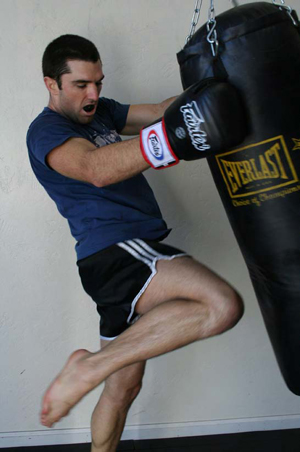
The above sessions allowed for fight specific anaerobic training and constant technical improvement. The anaerobic conditioning was brutal as Glen was forced to work against fresh opponents round after round. Most of his partners outweighed him by a significant amount. A highly objective measure of Glen’s metabolic conditioning was his eventual FGB score of 360 at a body weight of 165. It is interesting to note that Glen performed no other conditioning workouts besides evening sparring and these mid-day SSP sessions. I think that is interesting and quite validating of CrossFit’s insistence on “Constantly varied, functional movements, performed at high intensity.” At first glance this may not square with one’s notion of thrusters and pull-ups, Frans and Helens, but really what is more intense and functional than fighting? Where people can miss an opportunity for improvement is in a lack of variety in training. Sparring at too high an intensity for too long will lead to mental and physical exhaustion. With the above format we were able to dramatically improve Glens sport specific conditioning AND his general anaerobic conditioning. Although we used mixed modal workouts for Glen’s “pre-season” we could not afford the lack of specificity as fight time neared. There are other routes to get to a 360 Fight Gone Bad score but they will not provide both improved metabolic conditioning AND improved skill sets in stand-up, clinch and ground.
The above considered, we attempted to balance two mutually exclusive training adaptations: improved general conditioning and sport specific efficiency. Greg Glassman first exposed me to the work of Stephen Seiler and his Time Course of Training Adaptations. In essence one must become very efficient at a given activity to reach the highest levels of performance possible, yet one must also augment sport specific conditioning. This is the conundrum many face in that simply doing more of the same sport eventually leads to stalled or diminishing returns. We employed the above sessions such that the longer continuous sessions forced efficiency of movement on Glen’s part. All extraneous movement was polished out of his game and Glen became VERY adept at reading his opponent, thus allowing for economy of movement and conservation of energy. The short intense sessions imposed extreme demands that allowed continuous progress due to the unlimited variations in the sport specific conditioning. We could alter station order, who performed at the given station and of course the time variables. We were working five one-minute intervals. We could easily have worked 10 thirty-second intervals. These other sessions would be sport specific yet variable enough to ease some of the mental and physical stress of training while allowing for continual progress.
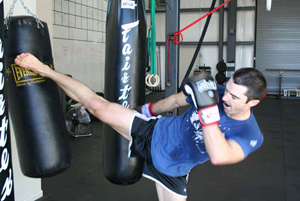
If Glen proved to be especially tired or beaten up, we dialed back the intensity or called that session altogether. In either case if the sport specific drilling looked like too much work, we put Glen through an easy session on the C2 rower, stretched, foam rolled and looked at video from previous sessions and discussed strategy. It is important to have a general guide and plan but it is equally important to be flexible and know how to keep the whole operation moving forward by taking a few steps back. This is of particular import for the S&C coach who must monitor recovery and decide when to dial back and when to push forward, all with the fight date looming in the near future. This process is often at odds with the desire of the fighter to go 100% all the time. Although this mindset and mental toughness is requisite to achieve the highest level in sport, so too is the ability to save a little for another day and bag the operation altogether if need be, to ensure forward progress.
The noon session always wrapped up with foam rolling, stretching, ice baths and review of that sessions video. Glen then shuffled home to eat, work and revive for his 5:00 pm session in Oroville.
5:00 pm
Glen’s 5:00 pm session involved no-Gi BJJ, sparring and mitt work. I did not participate in these sessions, but Glen took video and we discussed performance and strategy the following day.
Bravo?
As I mentioned previously, Glen writes for Victory Belt Publications and he occasionally flies to a location to shoot video or work with an individual on a project. About 18 days before Glen was to fight, he went to Legends Mixed Martial Arts Training Center to work with Eddie Bravo. In the course of training with Eddie and his students Glen was awarded his Purple belt from Eddie… and managed to tear his ulnar-colateral ligament. One “hurrah” and two “Oh Shits”. Glen was scheduled to fight March 31st and then four days later fly to Thailand to train and get in two or three pro fights. Due to the severity of Glens injury we pulled him from the March 31st card and shifted gears to rehab/maintenance mode so his Thailand trip would not be a complete wash… other than partying down for Songkhran! I’m not going to go into the rehab here, but I do want to highlight some of the improvements and subjective/objective measures of success we had for this fight preparation.
Objective Improvements
1. Improvement of Fight Gone Bad score from 276 to 360 in six weeks. Glen progressed from 276 to 310 during two weeks of CrossFit style programming. He then progressed from 310 to 360 only as a consequence of his strength circuit and MMA specific training. I find that very interesting.
2. Increased deadlift working weight from 62 kg to 100kg. This may seem a very insignificant increase and not an “impressive” weight overall, but this was Glen’s first exposure to these movements. I wanted to establish a base of technical proficiency while minimizing injury risk and recovery demands. I think Glen will easily achieve a 2.5-3.0 times bodyweight deadlift within six months of training once he returns from Thailand.
3. Decrease in body fat of about 5% while maintaining bodyweight at 165. This translates into in increase of about eight pounds of muscle while maintaining bodyweight. This objective measure squared well with a dramatic increase in Glen’s sport specific strength.
Subjective Improvements
1. Glen’s recovery ability, both within a session and from day to day, improved remarkably. Minor bumps and bruises healed seemingly overnight.
2. Glen’s stand-up clinch and ground improved dramatically, both in technical execution and aggression due to improved conditioning and skill refinement. The initial conditioning circuits witnessed Glen quickly fatigued and more often than not fighting from his back. In subsequent weeks however it was Glen’s partners who needed a break! It was rare that Glen did not have the upper hand during a session. Keep in mind Glen’s training partners were all experienced fighters and wrestlers.
3. Glen received his purple belt from Eddie Bravo. Glen was working essentially in isolation and is easily the most technically proficient BJJ practitioner in the Chico area. By analyzing tapes to pinpoint and fix technique flaws and by increasing his overall strength and conditioning, Glen was awarded his next rank in BJJ from one of the sport’s most respected instructors.
Nutrition
Glen followed a Paleo diet with no real restrictions on intake other than he consumed protein and carbohydrate meals post workout, typically chicken and yams. All other meals were protein, greens and good fats. These meals were typically salads with canned wild Alaskan salmon, veggies and olive oil. The only supplement Glen used was Kirkland fish oil at 10-15g/day of EPA/DHA. We used this loose, unweighed, unmeasured approach as it simplified the nutrition side of the game without introducing more time demands on Glen’s already busy schedule.
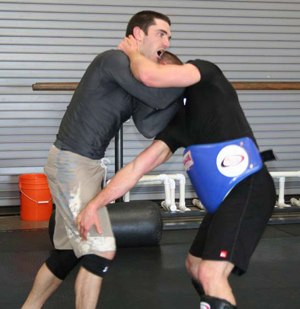
I was initially concerned that Glen might gain too much weight on this program. We monitored Glen’s weight daily and we were prepared to implement a weighed, measured Zone if Glen’s weight began to creep upwards. We simply kept portion sizes reasonable and used rough measures such as “a lot” of sweet potatoes after a very demanding training session and much smaller portions after relatively easy sessions. This allowed us to take advantage of the post exercise non-insulin-mediated glucose transport which minimizes insulin secretion. Since Glen had multiple training sessions this allowed for immediate, reasonable recovery that accentuated our body composition goal: Lose body fat, maintain bodyweight. I think this puts to bed the notion some in strength & conditioning put forward that the Paleo diet is sufficient to avoid the scourges of metabolic syndrome but not up to the task of fueling elite performance. And of course, it would be impossible to eat Paleo foods in a 40/30/30 ratio (wink)!
Acknowledgements
Thank yous are in order as many people gave in various ways to help Glen prepare. Dr. John Fragoso was our fight Doc and managed to keep Glen bouncing back from most of his bumps, bruises and contusions. Dr. Fragoso is also an excellent wrestler and a savage athlete. He helped in some of the fight prep circuits and had some of the best success of anyone at taking Glen down. Jason Pietz and Cedric Schwyzer are both accomplished MMAs and they were instrumental in helping Glen refine his technique and timing. Shawn Gower paid the ultimate sacrifice and met Pukie during one conditioning session. Also, NEVER give Shawn tequila when he stays at your house. Finally thank you to Nicki and all the NorCal S&C clients who put up with loud, sweaty guys thrashing about the gym at all hours. Shoot Glen an email if you have any questions about his training, Victory Belt projects, or how to survive Songkhran!

What’s the best approach? It’s tough just looking to the competitors of this relatively young sport. Win/loss has historically been an extension of technical proficiency, particularly in Brazilian Jiu-jitsu (BJJ) however that story has changed in recent times as we have witnessed wrestlers who possess phenomenal conditioning, heart and aggression winning many events and titles with only a modest understanding of BJJ and stand up skills. Thinking back to the beginnings of the UFC this was obviously not the case as smaller, weaker individuals could consistently win against larger stronger opponents, even wrestlers, given adequate technical advantage. Like I said however, times have changed! Now everyone at A-level competition has at least a working knowledge of take downs, submissions and their respective defenses. When the technical field converges upwards what then are the determinants of success? Louie Simmons has made the point that on average when two individuals of equal skill-set compete, the individual who is stronger will prove victorious. Some seem to interpret this to mean start a cycle of anabolic steroids in conjunction with a double split bodybuilding routine. That approach worked for some top-level competitors; however, the evolution of the sport is calling into question bodybuilding as an effective approach to Strength & Conditioning, even with the advantage of anabolics. I’d like to look at some integrative approaches and help to drag strength and conditioning for combatives out of the dark ages. This is not intended to be an exhaustive “How To” guide… that will come later! This is more an open communication of one fighters preparation for competition and what our strategies were along the way.
At NorCal S&C we had the good fortune of prepping a fighter for the rigors of MMA competition, one Glen “The Mad Man” Cordoza. Glen is a phenomenal athlete and coach and will be a major force in the lightweight MMA scene… trust me! Glen was a client of ours several years ago and proved to be a tough and supremely coachable athlete. He worked with us for about five months and then spent the better part of two years in Thailand wracking up an impressive professional Muay Thai record. In addition to Glen’s Thai boxing he had (at the beginning of our training) a blue belt in BJJ under John Frankl and a mountain of experience working with such fight luminaries as Randy Couture, BJ Penn, Marcello Garcia and Eddie Bravo to name a few. Glen’s day job is the role of author for Victory Belt publishing, so he gets to fly to exotic locations, interview the best fighters in the world, and help to write instructional books with these folks. If you like to dismantle people or write and read about the dismantling of people as Glen does, this is a pretty kick ass job.
Before we jump in I want to mention that whenever a client approaches me for help with an element of their performance it’s usually with a specific goal in mind. For some it may be an athletic event like Glen’s fight. For others it may be weight loss or working with a family doctor to reverse hypertension. Whatever the case it’s important for me to thoroughly inventory not only what the person wants or needs to accomplish but also to honestly evaluate where they currently are. From this we can engineer a plan that will address weaknesses and build on strengths to reach a mutually agreed upon goal. This may be obvious for many and I apologize if it seems trite or remedial, but it has been my experience that good coaches have sophisticated means of assessing a client’s status relative to a projected goal. With this information, rational planning can follow. This method also lends itself to cost/benefit projections of the form “Given our current set of circumstances this is how much suffering you will need to endure to get this desired outcome.”

With the above in mind, here is the scenario I faced for Glen’s fight preparation: Glen came to me interested in help with his strength & conditioning for a fight in late March. This was in early January and it seemed we had more than ample time to get Glen in top fight shape. I knew that Glen had excellent stand-up, clinch and ground games and he always took his conditioning seriously. We did, however, have a few interesting twists to this story from day one. The first was that Glen’s normal fight school had closed about three months previously. What this meant was that Glen had very little hands on sparring, rolling or drilling. The second issue was that Glen was in the middle of writing several books, including one with BJ Penn and another with Randy Couture. In essence big, important, time-critical books. The demands of book writing placed Glen in front of a computer for upwards of 10 hrs per day writing, editing and working on page layouts. Glen was stiff, moderately deconditioned (for him) and had a bit of rust on his game… and we had no legit fight school. Hey, we didn’t want this to be a cakewalk!
Once we established where Glen was and where we needed to take him the following points helped to focus our training:
1. Establish an objective measure of sport-specific conditioning.
2. Restore and expand Glen’s fighting skill sets.
3. Implement an effective S&C protocol.
Objective Measures
For an objective measure of sport specific conditioning I chose to use the CrossFit classic Fight Gone Bad. Glen had experience with this workout both from working with us in the past and in his time with BJ Penn. FGB is time indexed to match an MMA fight (three 5 minute rounds) and since Glen had familiarity with the test his improvements would accurately reflect performance improvements and not test improvement. In sports science language, Glen had gone through his acclimatization phase with the FGB test. Glen did however display significant muted hip function on several of the movements, perhaps most notably the push press. This improved over time and correlated nicely with improved scores on this activity. Glen’s first exposure to FGB produced a green, but not unimpressive 276. As we will see later, this number improved dramatically in the weeks to come and by somewhat surprising means.

Fight Skills
We began restoration of Glen’s stand-up, clinch and ground skills. I had a decent Thai boxing game at one time so we started working light, technical sparring to re-establish distancing and timing in stand up. Positional sparring was used in BJJ. We started work on the heavy bag and Thai pads. ALL sessions were videotaped and analyzed during flexibility training to make plans for the following day and shore up any weaknesses in the game.
Strength & Conditioning
Integrate effective strength & conditioning. Glen had never followed a specific strength training program. In the past he had used track intervals, dips, pull-ups and some band work for his training with quite good results; however, I wanted to bring up his absolute and relative strength without increasing his weight. Glen fights in the 155 class and runs right around 165. This is not a huge drop to make, but neither of us wanted to push that margin. This considered we started Glen on the deadlift, ring dips and pull-ups. Initially the dead lift was an awkward and challenging movement that exposed a surprising degree of hamstring tightness and what I call a “glassy” lower back. Tight hamstrings and hip flexors appeared to contribute to lower back pain from flexion at the hips. This alleviated with strength and flexibility work. I kept Glen very light and conservative on the strength movements, hammering form while keeping the rep range below 3 to minimize hypertrophy. Even at the light initial loading on the deadlift (62 kg) Glen noticed an immediate improvement in his game. We never maxed Glen but over the course of several weeks we worked him up to very comfortable sets with 100kg in the DL. I will detail this more later; however, it is stunning how much this improved strength added to Glen’s already formidable game. It is important to note also that this strength circuit of deadlifts, weighted pull-ups and weighted ring dip, required less than 15 min to perform and made virtually no inroads into Glen’s recovery capacity. This is a huge consideration when we are pushing the envelope of human performance.

With our objectives in place we started with 2 weeks of general “pre-season” work structured as such:
Warm-up including light shadow boxing, dynamic range of movement and 1K on the concept 2 rower. Next we either worked sport specific activities such as Thai pads, clinch work, BJJ positional sparring and heavy bag work OR we put Glen through his strength circuit comprised of the deadlift, weighted pull-ups and ring dips. I alternated these days so Glen would occasionally do his strength circuit in a fairly fatigued state.

Sets and reps on the strength circuit were 3-5 sets of 2-3 reps. As I mentioned previously, Glen had some difficulty with the deadlift in the beginning. Tight hips made proper position in the beginning of the lift a challenge and it was common for Glen to lose his lordotic arch upon initiation of the lift. Using dynamic range of movement and the Potato Sack Squat (© Dan John Inc) we were able to get Glen into a safe, ergonomically sound position for pulling. It is interesting to note that once we addressed positional/structural integrity, small technique errors in Glens pulling immediately improved. Similar to a math problem, the set-up proved to be all-important. I started Glen very conservatively on the DL with 62 kg and kept him there for about two weeks just hammering form. The ring dips and pull-ups were un-weighted for two weeks, then I began wave loading all the movements, adding a little weight for 2-3 consecutive workouts, then dialing back 1-2 steps. This may not seem to be very aggressive but amidst the rest of Glens training I wanted this strength circuit to be safe, productive and non-taxing. I had Glen move from one movement to the next, with about one minute rest between stations. This allowed for quick completion of the circuit but allowed for 3-4 minutes recovery between each station.
Once the strength circuit or sport specific practice was done we used some form of a mixed modal, CrossFit style circuit. We time indexed efforts to match about five minutes of work and one minute of rest for most workouts; however, I did play with shorter intervals to emphasize power. We also worked hybrid sessions in which Glen wore MMA gloves and included Thai boxing work on either pads or the heavy bag in addition to movements such as running, pull-ups and thrusters. We wrapped up the day with foam rolling, stretching and the daily plunge into the ice bath. Total training time ranged from 1.5-2.5 hours.
This initial two-week period of training brought Glen’s work capacity and anaerobic conditioning up pretty dramatically as evidenced by his 310 FGB score. This was certainly a plus; however, Glen often experienced extreme soreness from the metabolic sessions to a degree that made SSP work vary from unappealing to impossible. As I mentioned before, Glen has a solid MMA game, but we needed to cover many aspects of the fight preparation beyond just S&C. This was late January and a few of the people from the old MMA school in Chico put together a quasi-functional operation about 15 minutes outside of town. Glen could train here and get some reasonably good sparing, BJJ and expert pad work. At this point I wanted to accomplish the following:
1. Shift most conditioning to sport specific work. As the saying goes, the best way to prepare for a sport is to DO the sport. That considered, however, more and more of the same activity will lead to burnout unless volume, intensity and variety are managed effectively.
2. Increase the amount of skill work Glen performed.
3. Continue strength circuit work.
The schedule we developed allowed for a large volume of high quality work that accomplished both the above objectives. Here is what most days looked like:
8:00 am
Glen arrived at the gym and performed 15 minutes of shadow boxing for a warm-up. We developed call-outs that drilled certain combinations and responses. For example sprawling, counter-punching, circling, etc. Once Glen was warm we worked light, technical sparring with MMA gloves. We again worked many scenarios establishing “A” game combinations and then transitioned into open movement. Contact was quite light but movement was alive and spontaneous. We videotaped and analyzed each session. From this we planned the curriculum for the noon session, Glen’s evening sparring, and the following morning session. This process was remarkably productive, but the key to the efficacy lay in focusing on one or perhaps two elements to improve in the following sessions. It was tempting to try to fix everything at once, but by isolating one element, such as footwork during a combination, we were able to fix minor technical elements of Glen’s game that might otherwise go unnoticed. It may be tedious and a bit boring, but it is absolutely crucial to make significant technical progress. We concluded this session with foam rolling and light stretching.
12:00 pm
Glen went home after the morning session to eat and work on his writing. He then returned to the gym to work the intense skill/conditioning session for the day. This second session involved time-indexed fight training structured in one of the following formats:
Working with five different people for one minute each then a one-minute rest or an on going rotation of people lasting 15-20 minutes. In the case of the five-minute rounds we typically worked up to six rounds whereas the longer, continuous sessions lasted up to 40 total minutes in 15-20 minute increments. We utilized stations such as the following:
1. Thai pads. Mainly “A” game combinations attempting to pack as many into one minute as possible. This station was a pre-fatiguing technique that put Glen into a significant oxygen debt and consequently at a disadvantage for the following stations in which he faced a fresh opponent every minute while his fatigue mounted.
2. Single leg takedown defense. Glen started with his leg in his partner’s hands and then fought to avoid the takedown. If a takedown occurred a five-second scramble was allowed before breaking and resetting. This is an isolated drill and we wanted to emphasize the takedown defense, but we did NOT want to ingrain a sense that if Glen was taken down he could give up. Jeff Martin of Brand X Martial Arts relayed a story to me of police officers who have handed weapons BACK to assailants after disarming the individual because that is what the officers have done thousands of times in training. This five-second scramble allowed for a real sense of flow from clinch to ground as it would happen in a fight, but allowed for a great deal of focused work.
3. Escape from guard, mount, side control or similar position. Glen’s partner would start in one of these positions and they would reset if Glen managed to make it to his feet.
4. Thai and Greco clinch. We sometimes isolated the two styles of clinch work and sometimes integrated them. We worked to takedown, occasionally with unforeseen results such as my separated shoulder during one session. But hey, I got the takedown!

The above sessions allowed for fight specific anaerobic training and constant technical improvement. The anaerobic conditioning was brutal as Glen was forced to work against fresh opponents round after round. Most of his partners outweighed him by a significant amount. A highly objective measure of Glen’s metabolic conditioning was his eventual FGB score of 360 at a body weight of 165. It is interesting to note that Glen performed no other conditioning workouts besides evening sparring and these mid-day SSP sessions. I think that is interesting and quite validating of CrossFit’s insistence on “Constantly varied, functional movements, performed at high intensity.” At first glance this may not square with one’s notion of thrusters and pull-ups, Frans and Helens, but really what is more intense and functional than fighting? Where people can miss an opportunity for improvement is in a lack of variety in training. Sparring at too high an intensity for too long will lead to mental and physical exhaustion. With the above format we were able to dramatically improve Glens sport specific conditioning AND his general anaerobic conditioning. Although we used mixed modal workouts for Glen’s “pre-season” we could not afford the lack of specificity as fight time neared. There are other routes to get to a 360 Fight Gone Bad score but they will not provide both improved metabolic conditioning AND improved skill sets in stand-up, clinch and ground.
The above considered, we attempted to balance two mutually exclusive training adaptations: improved general conditioning and sport specific efficiency. Greg Glassman first exposed me to the work of Stephen Seiler and his Time Course of Training Adaptations. In essence one must become very efficient at a given activity to reach the highest levels of performance possible, yet one must also augment sport specific conditioning. This is the conundrum many face in that simply doing more of the same sport eventually leads to stalled or diminishing returns. We employed the above sessions such that the longer continuous sessions forced efficiency of movement on Glen’s part. All extraneous movement was polished out of his game and Glen became VERY adept at reading his opponent, thus allowing for economy of movement and conservation of energy. The short intense sessions imposed extreme demands that allowed continuous progress due to the unlimited variations in the sport specific conditioning. We could alter station order, who performed at the given station and of course the time variables. We were working five one-minute intervals. We could easily have worked 10 thirty-second intervals. These other sessions would be sport specific yet variable enough to ease some of the mental and physical stress of training while allowing for continual progress.

If Glen proved to be especially tired or beaten up, we dialed back the intensity or called that session altogether. In either case if the sport specific drilling looked like too much work, we put Glen through an easy session on the C2 rower, stretched, foam rolled and looked at video from previous sessions and discussed strategy. It is important to have a general guide and plan but it is equally important to be flexible and know how to keep the whole operation moving forward by taking a few steps back. This is of particular import for the S&C coach who must monitor recovery and decide when to dial back and when to push forward, all with the fight date looming in the near future. This process is often at odds with the desire of the fighter to go 100% all the time. Although this mindset and mental toughness is requisite to achieve the highest level in sport, so too is the ability to save a little for another day and bag the operation altogether if need be, to ensure forward progress.
The noon session always wrapped up with foam rolling, stretching, ice baths and review of that sessions video. Glen then shuffled home to eat, work and revive for his 5:00 pm session in Oroville.
5:00 pm
Glen’s 5:00 pm session involved no-Gi BJJ, sparring and mitt work. I did not participate in these sessions, but Glen took video and we discussed performance and strategy the following day.
Bravo?
As I mentioned previously, Glen writes for Victory Belt Publications and he occasionally flies to a location to shoot video or work with an individual on a project. About 18 days before Glen was to fight, he went to Legends Mixed Martial Arts Training Center to work with Eddie Bravo. In the course of training with Eddie and his students Glen was awarded his Purple belt from Eddie… and managed to tear his ulnar-colateral ligament. One “hurrah” and two “Oh Shits”. Glen was scheduled to fight March 31st and then four days later fly to Thailand to train and get in two or three pro fights. Due to the severity of Glens injury we pulled him from the March 31st card and shifted gears to rehab/maintenance mode so his Thailand trip would not be a complete wash… other than partying down for Songkhran! I’m not going to go into the rehab here, but I do want to highlight some of the improvements and subjective/objective measures of success we had for this fight preparation.
Objective Improvements
1. Improvement of Fight Gone Bad score from 276 to 360 in six weeks. Glen progressed from 276 to 310 during two weeks of CrossFit style programming. He then progressed from 310 to 360 only as a consequence of his strength circuit and MMA specific training. I find that very interesting.
2. Increased deadlift working weight from 62 kg to 100kg. This may seem a very insignificant increase and not an “impressive” weight overall, but this was Glen’s first exposure to these movements. I wanted to establish a base of technical proficiency while minimizing injury risk and recovery demands. I think Glen will easily achieve a 2.5-3.0 times bodyweight deadlift within six months of training once he returns from Thailand.
3. Decrease in body fat of about 5% while maintaining bodyweight at 165. This translates into in increase of about eight pounds of muscle while maintaining bodyweight. This objective measure squared well with a dramatic increase in Glen’s sport specific strength.
Subjective Improvements
1. Glen’s recovery ability, both within a session and from day to day, improved remarkably. Minor bumps and bruises healed seemingly overnight.
2. Glen’s stand-up clinch and ground improved dramatically, both in technical execution and aggression due to improved conditioning and skill refinement. The initial conditioning circuits witnessed Glen quickly fatigued and more often than not fighting from his back. In subsequent weeks however it was Glen’s partners who needed a break! It was rare that Glen did not have the upper hand during a session. Keep in mind Glen’s training partners were all experienced fighters and wrestlers.
3. Glen received his purple belt from Eddie Bravo. Glen was working essentially in isolation and is easily the most technically proficient BJJ practitioner in the Chico area. By analyzing tapes to pinpoint and fix technique flaws and by increasing his overall strength and conditioning, Glen was awarded his next rank in BJJ from one of the sport’s most respected instructors.
Nutrition
Glen followed a Paleo diet with no real restrictions on intake other than he consumed protein and carbohydrate meals post workout, typically chicken and yams. All other meals were protein, greens and good fats. These meals were typically salads with canned wild Alaskan salmon, veggies and olive oil. The only supplement Glen used was Kirkland fish oil at 10-15g/day of EPA/DHA. We used this loose, unweighed, unmeasured approach as it simplified the nutrition side of the game without introducing more time demands on Glen’s already busy schedule.

I was initially concerned that Glen might gain too much weight on this program. We monitored Glen’s weight daily and we were prepared to implement a weighed, measured Zone if Glen’s weight began to creep upwards. We simply kept portion sizes reasonable and used rough measures such as “a lot” of sweet potatoes after a very demanding training session and much smaller portions after relatively easy sessions. This allowed us to take advantage of the post exercise non-insulin-mediated glucose transport which minimizes insulin secretion. Since Glen had multiple training sessions this allowed for immediate, reasonable recovery that accentuated our body composition goal: Lose body fat, maintain bodyweight. I think this puts to bed the notion some in strength & conditioning put forward that the Paleo diet is sufficient to avoid the scourges of metabolic syndrome but not up to the task of fueling elite performance. And of course, it would be impossible to eat Paleo foods in a 40/30/30 ratio (wink)!
Acknowledgements
Thank yous are in order as many people gave in various ways to help Glen prepare. Dr. John Fragoso was our fight Doc and managed to keep Glen bouncing back from most of his bumps, bruises and contusions. Dr. Fragoso is also an excellent wrestler and a savage athlete. He helped in some of the fight prep circuits and had some of the best success of anyone at taking Glen down. Jason Pietz and Cedric Schwyzer are both accomplished MMAs and they were instrumental in helping Glen refine his technique and timing. Shawn Gower paid the ultimate sacrifice and met Pukie during one conditioning session. Also, NEVER give Shawn tequila when he stays at your house. Finally thank you to Nicki and all the NorCal S&C clients who put up with loud, sweaty guys thrashing about the gym at all hours. Shoot Glen an email if you have any questions about his training, Victory Belt projects, or how to survive Songkhran!
| Robb Wolf is the author of the best-selling book The Paleo Solution, co-founder of the Performance Menu, and co-owner of NorCal Strength & Conditioning. |
Search Articles
Article Categories
Sort by Author
Sort by Issue & Date
Article Categories
Sort by Author
Sort by Issue & Date

